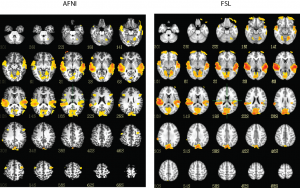Always nice when there is agreement between different neuroimaging packages. A quick block design analyzed in both AFNI and FSL – giving pretty similar results for the same participant.
Both packages have distinct advantages. For AFNI: 1) it’s faster ; 2) it has more customizable options; 3) the viewer allows you to adjust the p-value with a slider bar; 4) there is something to be said about being able to see the values for a particular voxel even after all of the processing has been done; 5) AFNI has some more advanced group analysis tools for doing mixed effects modeling (LME style) and meta-analyses (3dMEMA).
FSL really shines for having 1) a nonlinear transform; 2) a complete DTI analysis pipeline; 3) a GUI interface for new users (though AFNI’s uber_subject.py is competing there); 4) better documentation/help.
In the end though, you always have to know what you’re doing. And if you do – you should get roughly the same results with either package.
